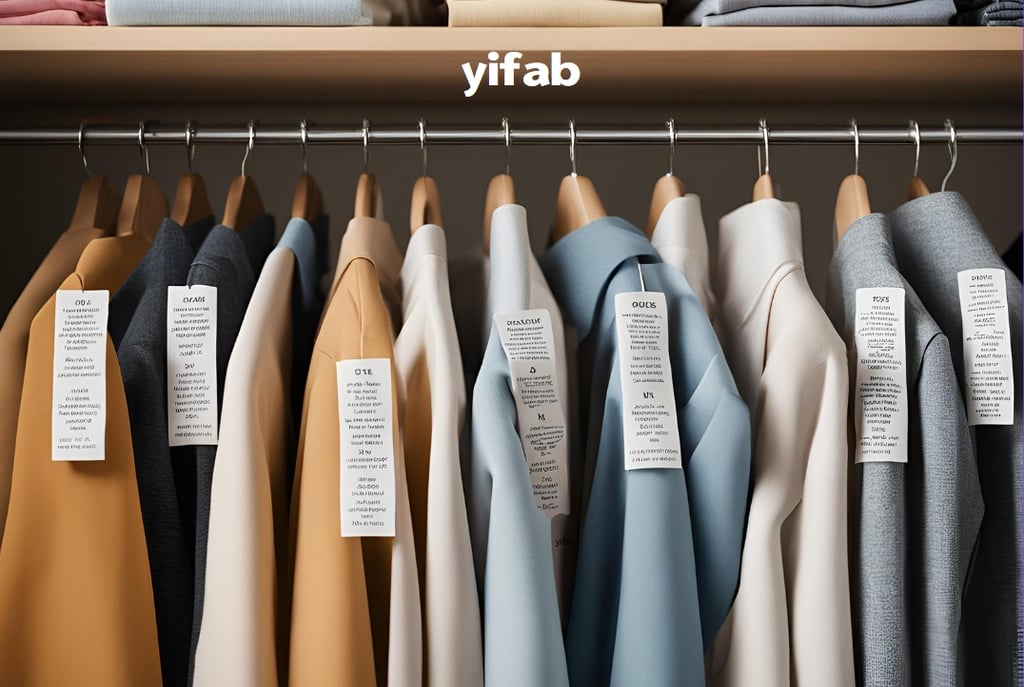Understanding Fabric Labels: What You Need to Know
Understanding Fabric Labels
10/14/20243 دقيقة قراءة


When shopping for clothes or home textiles, the fabric label is often overlooked. Yet, it holds vital information about the material, care instructions, and sustainability of the product. Understanding these labels can help you make informed purchasing decisions, extend the life of your garments, and even promote more sustainable fashion choices. Let’s dive into what fabric labels tell you and why it matters.
1. Fiber Content: What Is It Made Of?
The first thing you’ll notice on a fabric label is the fiber content, which indicates what the material is made from. Common fibers include:
Cotton: A breathable, soft natural fiber. It's versatile, comfortable, and often easy to care for.
Polyester: A synthetic fiber known for its durability, wrinkle resistance, and moisture-wicking properties. However, it's less breathable than natural fibers.
Wool: A natural fiber that provides excellent insulation. Wool garments are ideal for colder weather and are often labeled as merino, cashmere, or alpaca.
Silk: A luxurious natural fiber known for its smooth texture and elegant appearance.
Linen: A natural fiber from the flax plant, linen is breathable and ideal for warm weather but tends to wrinkle easily.
Understanding fiber content helps you know what to expect in terms of comfort, durability, and care. For example, cotton is soft and breathable, but it may shrink if not washed properly, while polyester is durable but less comfortable in hot climates.
2. Care Instructions: How to Maintain Your Fabrics
Care symbols on fabric labels provide essential guidance on washing, drying, ironing, and bleaching. Some common care instructions include:
Machine Wash: Indicates the garment can be washed in a washing machine, often accompanied by a temperature recommendation.
Hand Wash: Garments labeled for hand washing are delicate and could be damaged in a machine.
Dry Clean Only: This label is typically found on delicate fabrics like silk or wool, which can be damaged by water or home washing.
Tumble Dry: Indicates if the item can go in a dryer and at what temperature (low, medium, or high heat). If the label says "Do not tumble dry," opt for air drying to avoid shrinkage or damage.
Ironing: A symbol resembling an iron indicates if the item can be ironed. The dots inside the iron symbol show the recommended temperature: one dot for low heat, two for medium, and three for high heat.
By following these instructions, you can prolong the life of your garments and avoid damage such as shrinkage, color fading, or fabric warping.
3. Sustainability and Certifications: Going Green
With sustainability becoming a priority, many fabric labels now include information about the environmental impact of the product. Look for certifications such as:
OEKO-TEX® Standard 100: Indicates that the fabric has been tested for harmful substances and is safe for human use.
Global Organic Textile Standard (GOTS): Certifies that the fabric is made from organic fibers and meets environmental and social criteria throughout the production process.
Fair Trade Certified: Ensures that the workers who produced the fabric were paid fair wages and worked under ethical conditions.
Recycled Content: Some labels will specify if the material is made from recycled fibers, such as recycled polyester or nylon, which helps reduce waste and energy consumption.
These certifications allow you to make eco-friendly choices by selecting fabrics that are safer for the environment and produced under ethical standards.
4. Sizing and Fit Information
In addition to material and care information, fabric labels often provide important sizing and fit details. This can include the garment’s dimensions, whether it’s pre-shrunk, and how much it may stretch. This information is particularly useful when choosing fitted garments like jeans or tailored shirts, ensuring that you pick the right size and avoid shrinkage surprises.
Conclusion
Understanding fabric labels empowers you to make smarter purchasing decisions, from choosing the most comfortable and durable fabrics to following proper care instructions that extend the life of your garments. Whether you’re prioritizing comfort, style, or sustainability, the information on fabric labels is key to making the right choice. Next time you shop, take a closer look at the label—your clothes (and the environment) will thank you!
